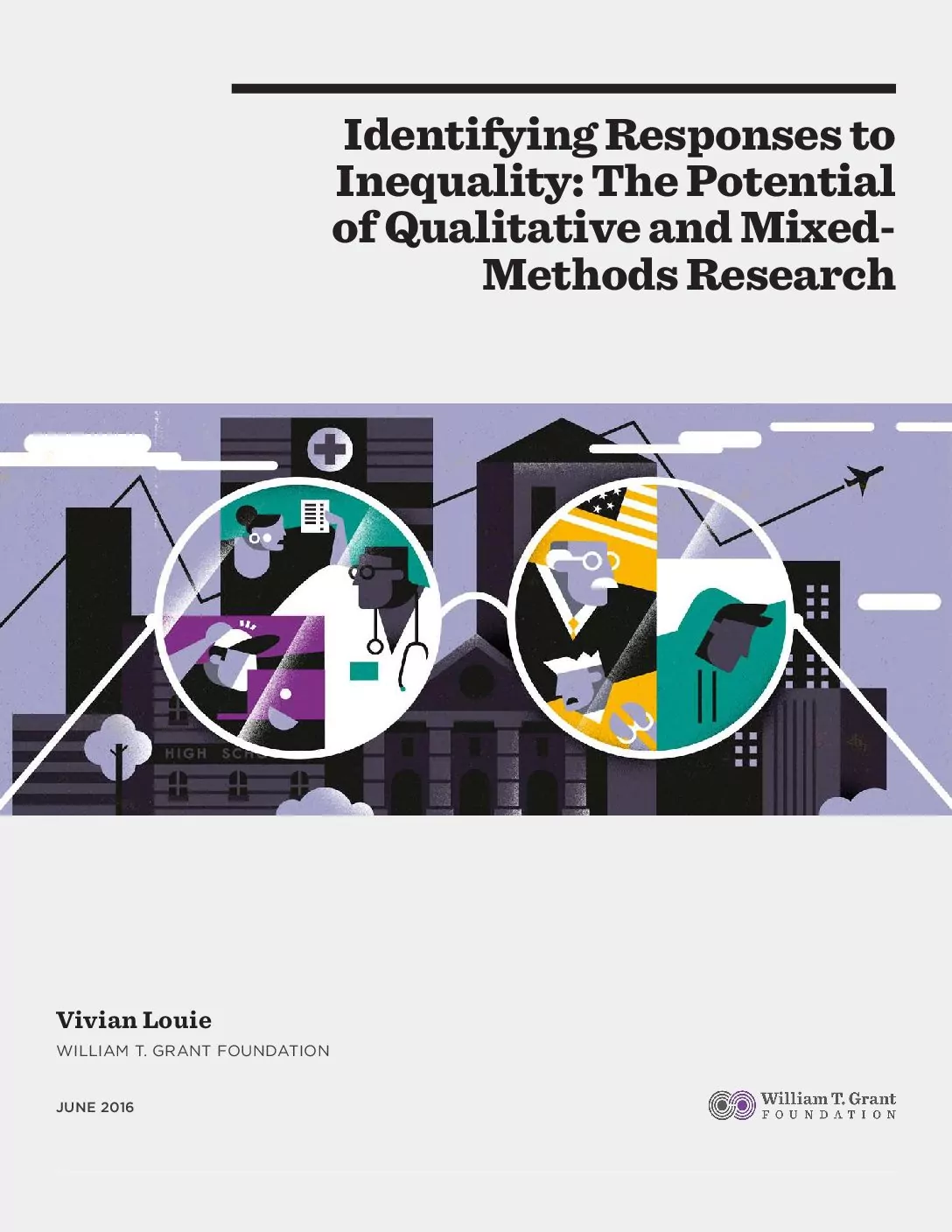Reducing inequality for youth ages 5 to 25 in the United States is one of our primary research interests. The defining element of the Foundation’s work in this area is our focus on responses to inequality—not the causes, contours or consequences of inequality, which have been the point of much prior work. We believe that research that uses qualitative or mixed methods is essential to building and understanding programs, policies and practices that reduce inequality in youth outcomes.1
Qualitative studies have a powerful role to play in reducing inequality, as they can potentially reveal and richly describe the patterns underlying cultural and social relationships. Qualitative studies can also bring to light how these patterns can be changed. Mixed-methods studies leverage the strengths of qualitative work in combination with quantitative studies. For the purposes of this essay, we broadly define quantitative studies as those that have variables as the units of analysis, employ hypothesis testing and mathematical analyses, and result in generalizable findings.2 We broadly define qualitative studies as those that have cases as the units of analysis, and involve analyses of people’s behaviors, perspectives, and subjective experiences.
Since the launch of our reducing inequality initiative in 2014, we have mainly received applications to study questions that beg quantitative studies. But we see research to reduce inequality as a complex endeavor—one that uses a wide range of designs and methods to investigate important questions that they are well suited to answer. As part of the Foundation’s larger effort to attract—and fund—qualitative and mixed-methods studies, this essay has two primary aims: 1) to highlight why and how qualitative and mixed-methods studies are crucial to reducing inequality, and 2) to showcase qualitative and mixed-methods research that we funded as part of our previous focus on understanding the social settings of youth development.
Why qualitative research?
With its focus on meaning making, qualitative research has a particular power to reveal the “how” of human experience, and, thus, also the “why.” Qualitative methods can get to the meaning of events, concepts, situations and behaviors as people understand them; they can uncover the contradictions in these interpretations, and richly describe and explain how and why people understand or experience the same thing in different ways. In the process of this research, we gain insight into how broader social forces shape individuals’ lived experiences and the ways in which they respond. This information is crucial to understanding, for instance, why a policy works in some places but not in others, or why a given practice might create unintended challenges. These kinds of realities form the fuller picture of inequality that is critical to see if we are to understand how to effectively respond to inequality.
Let us consider what we might learn from qualitative research that examines two policies aimed at improving the outcomes of poor children and youth. One is a welfare-to-work policy for poor mothers; the rationale here is that increased maternal employment leads to improved academic outcomes for the children. The second policy requires high-stakes testing in public schools; the rationale here is that children will do better if they are held to higher standards. Quantitative inquiries are well-positioned to investigate whether each policy impacts youth outcomes and the nature of that impact. But a limitation of quantitative work, as it relates to this example, is that the relationship between the two policies and youth outcomes would remain difficult to understand. Qualitative inquiry, however, affords the opportunity to explore this relationship, and, in turn, reveal contradictions in the policies’ goals that might interact and result in poor outcomes for children. Thus, if we are interested in why an impact occurs or does not occur, we should investigate how the individuals who are affected by the policies respond to them. For this, qualitative inquiry is particularly useful.
In pursuing these questions, Katherine Newman and Margaret Chin exposed a misalignment between the goals of each of the aforementioned policies that resulted in potential negative impact for children. They found that the time crunch from the new jobs of the welfare to work policy left mothers less time to be with their children, just when that time was becoming even more critical as their children were preparing for high-stakes tests at school. To effectively respond to inequality and improve youth outcomes, policymakers should consider these kinds of realities, which qualitative research is well-suited to reveal.
Qualitative methods speak to the meaning of events, concepts, situations and behaviors as people understand them; they can uncover the contradictions in these interpretations and richly describe and explain relationships.
Mixed-methods studies, which pair qualitative and quantitative methods, are necessary because they have the power to yield generalizable findings along with related insights that tap into people’s lived experiences and “the subtle, often invisible social mechanisms” that affect those experiences. Consider the research of Jonathan Guryan, a grantee funded under the Foundation’s former initiative on understanding youth social settings. Along with his colleagues, Guryan worked with the Chicago Public Schools to test an intervention that had been found to have promising effects on student attendance and school persistence. Guryan and his colleagues sought to learn more about the program’s impact on school-related outcomes for students in grades 1–7; the team embarked on a nuanced mixed-methods study that focused on the social processes and mediating mechanisms that drove the program’s effects. Quantitative analyses indicated that the intervention had a significant impact on attendance. These analyses did not speak to why students were chronically absent, but the qualitative component of the research did.
To get to why, however, there first had to be attention paid to how. In this case, the researchers needed to investigate how students decided whether to go to school or not. Interviews with students opened a window into the complexities of their daily lives, revealing, for instance, how many of them were confined to their homes due to the uptick in neighborhood violence in Chicago, and how their school absences were driven more by home and familial factors like parental illness than purposely skipping or avoiding school. That students were chronically absent, then, had little to do with schooling itself.
A clear need exists for the kinds of penetrating research questions that qualitative and mixed methods are well-suited to answering.
This example shows what we gain when quantitative research, where one must anticipate what needs to be measured, is paired with more open-ended qualitative methods, where one can gain unexpected but nevertheless important insights. In this case, efforts to address student absenteeism and improve academic or social-emotional outcomes could possibly be improved or developed by learning why students are chronically absent. And the answers to this question might point to unanticipated non-school factors that could be further examined.
In sum, qualitative and mixed-methods approaches are essential to identifying and understanding effective means to reduce inequality. Reducing inequality involves equalizing outcomes, which can be readily measured, but it also requires capturing the meanings attached to the sociocultural, political, and psychological aspects of inequality, whether among individuals or institutions. And it requires analyzing how these meanings inform the interactions between individuals, and between individuals and institutions, thereby enabling researchers to answer how and why particular responses to inequality might be effective.
Given our call for research on building, understanding, testing, and improving programs, policies, or practices to reduce inequality, a clear need exists for the kinds of penetrating research questions that qualitative and mixed methods are well-suited to answering.

















